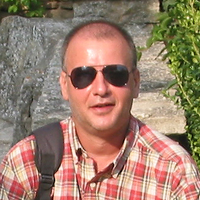Papers by Michael Oristaglio

The leading edge, Dec 1, 2013
In September, SEAM Corporation signed a contract with Advanced Geophysical Technology to carry ou... more In September, SEAM Corporation signed a contract with Advanced Geophysical Technology to carry out simulations of 3D land-seismic data acquisition on the SEAM Unconventional Model. This model of shale reservoirs set in the stratigraphic sequence of a typical midcontinent basin was designed by members of SEAM Phase II to represent challenges in the exploration and characterization of unconventional plays with seismic methods. Previous articles in this series have described the geology of the Unconventional Model and its digital construction through work that was carried out on behalf of the consortium largely by BP, using its internal geologic modeling software, including a novel program for simulating the deposition of fine stratigraphic layers controlled by a set of geologic rules (Figure 1; see TLE March 2013, page 346). This article describes the acquisition plan for the simulations and some numerical features of the model.

The leading edge, Apr 1, 2014
On 29 January, production synthetic seismic simulations began on the SEAM Phase II model of uncon... more On 29 January, production synthetic seismic simulations began on the SEAM Phase II model of unconventional shale reservoirs, now called the Barrett Unconventional Model (see Acknowledgments). The 3D rendering in Figure 1 highlights the model's major features. Structurally, it consists of three distinct regions: At the top is a near-surface zone extending from the (flat) earth-air interface to a depth of approximately 300 m; from the bottom of the near surface down to the top of the reservoir region, which is at a depth of about 2.5 km, is an overburden consisting of quasi-parallel sand, shale, and shaley-sand layers in a stratigraphic sequence that is cut by two large high-angle faults and is penetrated by a meandering stream channel. The reservoir region at the base of the model is about 1.25 km thick and consists of two organic-rich shale layers separated by a thick chalk layer.
Elsevier eBooks, 2014
Abstract Chapter 10 contains a brief description of the field generated by the horizontal magneti... more Abstract Chapter 10 contains a brief description of the field generated by the horizontal magnetic dipole over the horizontally layered medium. An appropriate boundary valued problem is solved in terms of vector potential and resulting expressions are presented. Some special attention is paid to the behavior of the vertical component of the electric field in the model in question.

Geophysics, 1981
A field test was carried out of a controlled‐source induction procedure in which a source loop wa... more A field test was carried out of a controlled‐source induction procedure in which a source loop was positioned on the surface of the ground encircling a borehole, and the horizontal component of the magnetic field was measured within the hole. The problem of measuring the component of an alternating magnetic field at right angles to a small diameter hole was overcome by the construction of a μ‐metal frame for the induction coil that greatly increased the effective cross‐section of the coil. Data obtained with this configuration of source and receiver are dependent upon the electrical conductivity of the ground within a broad region around the hole. The method is effective in providing constraints on the location and distribution of regions of anomalous electrical conductivity which are not revealed by the drilling operation. These conclusions are supported by theoretical estimates of the magnetic field that would result from known conductivity distributions obtained using finite element techniques.
Elsevier eBooks, 2014
Abstract In chapter 3 we study the behavior of electromagnetic field in the nonconducting medium.... more Abstract In chapter 3 we study the behavior of electromagnetic field in the nonconducting medium. We focus on a wave equation and figure out wave propagation phenomenon. Electromagnetic plane wave behavior is described in detail. Also, a quasi-stationary field in a nonconducting medium is considered, as well as induction in conductors due to the time-varying external field, particularly, sinusoidal oscillations. Field's spectrum is analyzed and its high-frequency and low-frequency approximations are obtained.
Geophysics, Feb 1, 1986
We describe a method to decompose a two‐dimensional (2-D) elastic wave field recorded along a lin... more We describe a method to decompose a two‐dimensional (2-D) elastic wave field recorded along a line into its longitudinal and transverse parts, that is, into compressional (P) waves and shear (S) waves. Separation of the data into P-waves and S-waves is useful when analyzing vector seismic measurements along surface lines or in boreholes. The method described is based on a plane‐wave expansion for elastic wave fields and is illustrated with a synthetic example of an offset vertical seismic profile (VSP) in a layered elastic medium.
Elsevier eBooks, 2014
Chapter 12 is devoted to controlled-source electromagnetic sounding, namely the frequency and tra... more Chapter 12 is devoted to controlled-source electromagnetic sounding, namely the frequency and transient sounding. Again, starting with history of these techniques, we consider their theoretical background and provide analysis of apparent resistivity curves in simple 2- and 3-layer models.

Methods in geochemistry and geophysics, 2014
Principles of Electromagnetic Methods in Surface Geophysics contains information about the theory... more Principles of Electromagnetic Methods in Surface Geophysics contains information about the theory of electromagnetic fields in a conducting media. It describes the theoretical and physical principles of the main geophysical methods using electromagnetic fields, including frequency and transient soundings, electromagnetic profiling, and magnetotelluric soundings. Special attention is paid to models and signal processing methods used in modern exploration geophysics for groundwater, mineral and hydrocarbon exploration. * Offers an integrated approach to the description of electromagnetic geophysical fields used for surface geophysical surveys. * Provides a clear introduction to the physical background of electromagnetic methods and their application. * Rounds off the treatment of the main geophysical methods: gravity, magnetic seismic, electric and electromagnetic methods
The leading edge, Sep 1, 2013
Elsevier eBooks, 2014
In Chapter 9 the results presented in Chapter 8 are generalized to the case of horizontally layer... more In Chapter 9 the results presented in Chapter 8 are generalized to the case of horizontally layered medium. We start with formulating boundary value problem, for 3-layer structure and work out solutions to obtain accurate expressions involving integration of Bessel functions. As a result of this approach, a number of asymptotic expressions are derived, which allow one to understand the field behavior in approximations like wave/near zone. Then generalization to N-layered model is made. Time-domain responses are analyzed by making use of series expansion to evaluate asymptotic formulas. A number of specific models are considered including thin sheet S-plane and 1D layered sequence with non-conducting basement.
SEG Technical Program Expanded Abstracts 1986, 1986
Symposium on the Application of Geophysics to Engineering and Environmental Problems 2002, 2002
(2) , Douglas Miller (3) , Maclyn Burns (4) , Anthony Derubeis (5) , Paul Albats (6) , Robert Cas... more (2) , Douglas Miller (3) , Maclyn Burns (4) , Anthony Derubeis (5) , Paul Albats (6) , Robert Casadonte (7) , Ross Deming (8) , Ralf Birken (9) , Jakob Haldorsen (10)
Elsevier eBooks, 2014
In this chapter we cover the fundamental aspects of time-varying electromagnetic field behavior. ... more In this chapter we cover the fundamental aspects of time-varying electromagnetic field behavior. At first, Faradey's law (of electromagnetic induction) and Principle of charge conservation are considered. Then, we analyze the role of electric charges and work out equations governing charge distributions in case of time-varying fields. Then we proceed to another important source of electromagnetic field, namely, displacement currents. To account for all these phenomena we come up with extension to Maxwell's equations system. We also obtain separate equations for fields E and B and introduce electromagnetic potentials. Then we cover the issues relating electromagnetic energy transformations, including Joule's law and Poynting vector. Finally, we give a proof of uniqueness theorem for a forward boundary problem for time-varying electromagnetic field.
A new formalism and an old heuristic for seismic migration. [SEG Technical Program Expanded Abstr... more A new formalism and an old heuristic for seismic migration. [SEG Technical Program Expanded Abstracts 3, 704 (1984)]. D. Miller, M. Oristaglio, G. Beylkin.

Radio Science, Jul 1, 1994
A new inversion algorithm for the simultaneous reconstruction of permittivity and conductivity re... more A new inversion algorithm for the simultaneous reconstruction of permittivity and conductivity recasts the nonlinear inversion as the solution of a coupled set of linear equations. The algorithm is iterative and proceeds through the minimization of two cost functions. At the initial step the data are matched through the reconstruction of the radiating or minimum norm scattering currents; subsequent steps refine the nonradiating scattering currents and the material properties inside the scatterer. Two types of basis functions are constructed for the nonradiating currents: "invisible" (global) basis functions, which are appropriate for discrete measurements and nonradiating (local) basis functions, which are useful in studying the limit of continuous measurements. Reconstructions of square cylinders from multiple source receiver measurements at a single frequency show that the method can handle large contrasts in material properties.










Uploads
Papers by Michael Oristaglio